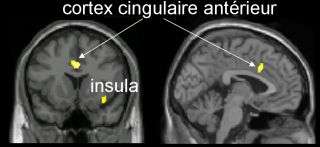The brain predicts our perception of the outside world

The human brain anticipates our perception of the outside world. For example, it is capable of predicting if we are going to perceive tactile stimulation of weak intensity or, on the contrary, if a more intense stimulation will be perceived more or less painfully.
If people can make these observations empirically, a team of researchers at the Coma Science Group of University of Liege (Cyclotron Research Centre) and Neurology Department at the University Hospital of Liege (Belgium) is today demonstrating it scientifically through measuring the spontaneous activity of the brain and the relationships between the different cerebral regions involved
In a study published this week in the Proceedings of the National Academy of Sciences (PNAS), the team of scientists led by Dr Mélanie Boly and Dr Steven Laureys shows that the spontaneous activity measured in certain parts of the brain have a direct influence over our conscious perception and our perception of the intensity of pain. ‘Our brain is never really at rest, but science does not have a good understanding of how the spontaneous and continuous activity of our neurons influences our perception of the world. Our study contributes to lifting a corner of the veil over these mechanisms’, the researchers state.
Using functional magnetic resonance imaging (fMRI) and laser stimulation of the skin’s nervous structures (stimulation in a thousandth of a second), the researchers brought to light the regions more specifically involved in this spontaneous brain activity. Thus, the awareness of self and of our internal world is increasingly connected to the activity in a network that includes the precuneus and posterior cingular cortex and the temporoparietal junction. However, awareness of our external world is linked to the activity measured in the thalamus and the frontoparietal lateral cortical zones. As regards the anterior cingular cortex and the insular cortex, they predict whether the laser stimulation will be perceived as more or less painful.
These results improve our knowledge of the mechanisms involved in human consciousness and allow for a better understanding of why we are at times more "sensitive" to pain than we are at other times. "Awareness has two components: awakening, on the one hand, and awareness of the environment (the external world) of self (the internal world), on the other. We knew the regions involved in awakening. With this study, we will demonstrate now that awareness of our internal and external world has different neuronal correlates and how they interact", the ULg researchers conclude.
Article: www.pnas.org/cgi/content/abstract/0611404104v1
Source: University of Liège




















